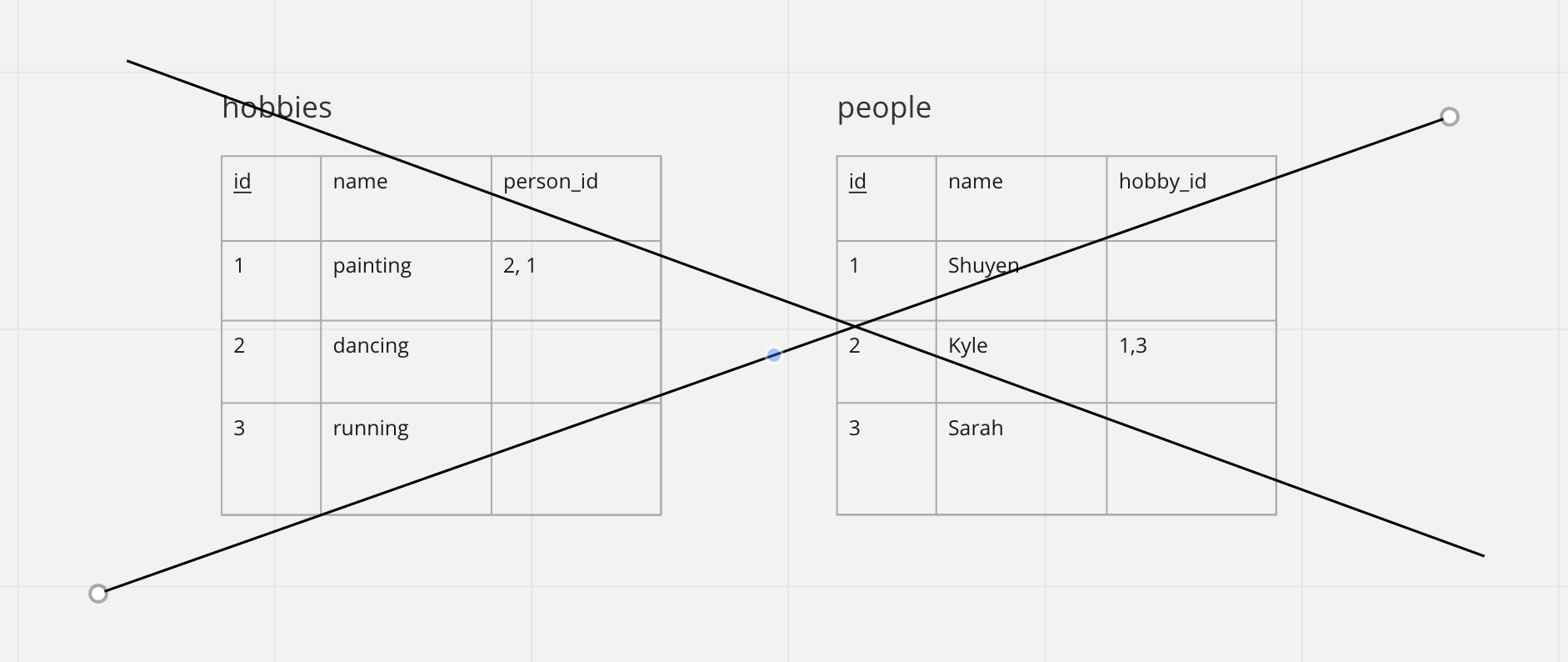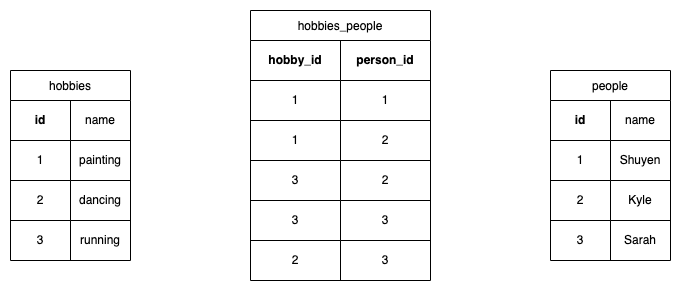4 Many-to-many
The second of our two relationship types is used when entities have a “many to many” relationship. A good example of a many-to-many relationship is a tagging system, such as Book and Genre. A genre like “mystery” or “horror” clearly includes many different books, but it is equally true that each book can be from more than one genre (although many will have only one.) Another good example are people and their hobbies: many people like to paint, and some of those people also like to dance.
One way of recognizing the many-to-many relationship is to draw out some concrete examples and use lines to join up those that are associated with each other. Here we work with some hobbies and people that enjoy them.

If you see objects on both sides with multiple lines coming from them, then you know that you have a many-to-many. Above, for instance, “paint” and “running” each point to two people. On the other side, “Sarah” and “Kyle” each point to two hobbies. Because both the hobbies side and the people side both have data points that send out multiple lines, we have a many-to-many relationship.
When we draw our conceptual ER diagram we get a crows-foot on both ends of the line:

We can read this as “A single Hobby could be pursued by many People” and, reversing direction, “A single Person could enjoy many Hobbies” We have a crows foot on both ends of the line, which means that we have a many-to-many relationship.
4.1 Locating foreign keys for many-to-many
Representing a many-to-many relationship in tables still uses primary keys and foreign keys. But it isn’t enough to put a foreign key in one table. If we just put hobby_id into the people table, then that would limit each person to having only 1 hobby. Similarly if we just put person_id into the hobbies table, each hobby could only be enjoyed by 1 person. And it’s no help having foreign keys in both tables (we are avoiding any structure with a list in a cell, because it massively complicates querying).

We solve this problem by having adding a third table. Then we have the two entity tables (one for hobbies and one for people), as well as one that sits between them. The physical ER diagram shows this middle table:

We call this third table a Simple Association Table. Informally these tables are often called “join tables” or sometimes “intermediate” tables (but this can be confused with the result of a JOIN, so I prefer “simple association table”).
Note that now we show this 3rd table in the physical ER diagram, notice that we don’t have crowsfeet at both ends now, now we have two one-to-many lines with the crowsfeet at the middle table.
The table sketch looks like:

Each entry in the entity tables has only one row and those tables don’t have foreign keys for this relationship. The table in the middle, though, has both foreign keys. In fact it only has both foreign keys. Simple Association Tables are special because they don’t have an id column of their own, they only have foreign key columns. As before we name a foreign key column with the name of the table it refers to, making it singular, and adding _id. Thus the foreign key referring to the hobbies table is hobby_id and the foreign key referring to the people table is person_id.
Now we can have a row for each of the lines that we drew above (five lines, five rows). Each hobby_id can show up on multiple rows, and each person_id can show up on multiple rows.
You might be wondering, though, why we can double rows in here but not in the entity tables and how we can get away with not having an id column. The answer is that the combination of the foreign keys is unique: we can only have one row linking a specific hobby and a specific person. This we call a composite primary key. We show that in the table sketch by underlining/bolding both of the foreign keys (rather than just id which is underlined/bolded in regular tables);
We show a composite primary key in the physical ER diagram by having PK next to both columns. We don’t say that both columns are “a PK”, rather we say that both columns are “in the PK”.
4.2 Naming conventions for simple association tables
The simple association table is named in lowercase but with a name made up by joining the two tables names in alphabetical order. We always work to show it sitting between the entity tables that it joins. Thus we hobbies_people (and not people_hobbies because h comes before p in the alphabet.) We use the pluralized form because the table names are pluralized.
Note that the simple association table does not show up in the conceptual ER diagram, but it does show up in the physical ER diagram and in the table sketches. So there can be more tables than there are boxes in the ER diagram.
4.3 Modeling Exercise (in-class)
Form five groups and you will be assigned one of the relationships below. Each should be modeled with just two entities (two boxes) and one relationship between them (one line). Hint: they are all many-to-many with a simple association table :)
You should:
- Brainstorm some concrete instances. You can start with full sentences or jotted notes, but you must have some real world examples to begin your modeling. Draw the “crossing lines diagram” as at the top of this page.
- Begin to develop your conceptual ER diagram. Remember to read your diagram using the “A single” structure.
- Develop your physical ER diagram; you will add the simple association table at this point.
- Sketch the entity tables and insert your concrete example data from step 1. (check that you are correctly using snake_case).
- Sketch the simple association table and add the foreign keys.
Exercises (all many-to-many with 2 entities, but 3 tables)
- Books and genres
e.g., The Lord of the Rings is a Fantasy book, but The Hobbit is Young-Adult as is The Hunger Games. - Photos and tags e.g., Photo21 was tagged “cute” “adorable” and “dog”. Photo23 was tagged “dog” and “large”.
- Shows that actors have been in (over their career) e.g., Hugh Laurie acted in both House, M.D. and Blackadder. Blackadder also starred Rowan Atkinson and Stephen Fry
- Individual buses which are used on bus routes.
_e.g., Route 37 was served by three individual buses this morning: 5PCL23, U89S32, and U28628 (The specific vehicles identified by license plates)._ 5PCL23 was used on Route 4 in the afternoon. - Races and competitors (no results) e.g., Shuyen, Sarah, and Swati all competed in the half-marathon. Only Swati competed in the 10,000m.
Don’t forget to brainstorm some more concrete instances and include them as sample data in your table sketches!